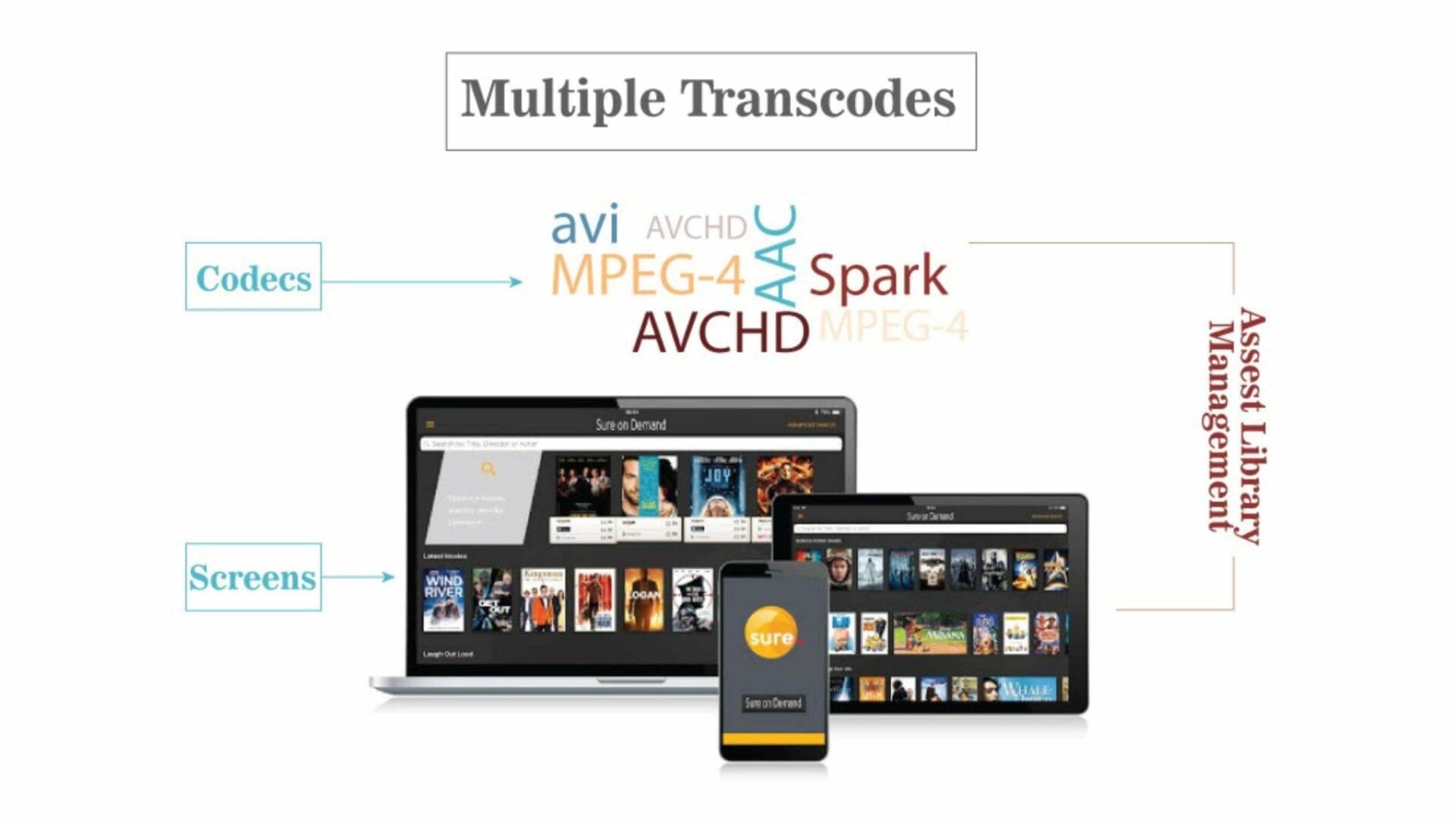Video has become the primary means of information sharing and learning. Customers are investing in innovative solutions to tap into the e-learning and video space. Video content is their IP and needs to be protected and securely delivered. Online video is a powerful technology that every industry, from businesses to educational institutions to government agencies, is increasingly taking advantage of.
Many businesses and organizations need a secure streaming solution. In particular, the following groups should consider security an absolute necessity: medical institutions, universities and schools, corporations, OTT and media businesses and government offices.
Today, more and more businesses are using video streaming platforms to host and share content. Both live streaming and video-on-demand (VOD) are incredibly powerful tools that businesses and enterprises of all kinds can use to boost revenue, communicate effectively, and build an audience.
In this blog we will be covering;
Video-on-demand (VOD) is an umbrella term referring to enabling individuals to select videos from a central server for viewing on a television or computer screen. Technically, VOD is a media distribution system that allows users to access videos without a traditional video playback device and more importantly without the restrictions of a typical static broadcasting schedule. It follows the process opposite to broadcast television programming.
Examples of VOD are:
Over-the-top (OTT) is a category of VOD that uses the internet to stream media in comparison to conventional streaming of televisions that is streamed via satellite.
Examples of OTT are:

Presently, the biggest challenge for building a media streaming platform is the various devices available that play the content differently from each other. Be it a tab, mobile phone, Alexa, tv, or other operating systems, all have different functions and one has to create customization for each. This is a critical choice that a company has to make because it is necessary to allow users to play their content through their preferred device.

We have to understand that every device requires different codecs. In the last decade, H.264 was the most widely used codec. The tech industry infact, rallied around one codec for streaming video files over the internet: MPEG’s AVC/H.264.
More devices = more codecs
Adopting the new generation compression technology is important because compressing video files means you can send higher-quality video over the same network infrastructure, for a richer, more compelling viewer experience and reduce delivery costs for popular content.
In the current market, new codecs are available, which offer 30%-40% more high compression techniques than H.264. It’s very important for any application developer or architect to adopt new generation techniques otherwise their devices might not work on different devices. Developers need to understand the importance of technology upgradation.
At Mindbowser, we bring the best of technology & knowledge for founders. In case you would like to discuss your options further, feel free to book a 30 minutes consultation call.
Get Free Consultation!Video encoding is essential as it allows transmitting video content over the internet efficiently. Encoding is significant because the raw video’s compression reduces the bandwidth and makes it easier to transmit. With the power of encoding, we can stream online video on multiple devices on our smartphones, tablet, and desktop. It also allows doing video calling/ chatting across the globe with low bandwidth and is owed to online video encoding.
Fig: Video encoding process
To provide superior customer experiences, many companies use Content Delivery Network services. You can choose a CDN based on your business needs. The choice of CDN should be made based on:
Fig: Choice of CDN
A CDN enables the quick transfer of the assets needed for uploading Internet content, including javascript files, HTML pages, stylesheets, images, and online videos. The popularity of Content Delivery Network services continues to grow. Today most web traffic from websites such as Netflix, Facebook, Amazon, etc is served by CDNs.
HLS stands for HTTP Live Streaming. It is a video streaming protocol for delivering audiovisual media to viewers over the internet. This live streaming protocol was first launched by Apple when they launched the first iPhone. It is used to implement an adaptive bitrate streaming format. The most crucial feature that HLS offers is that it can adapt the bitrate of the video to the actual speed of the connection. HLS streaming videos are delivered from a container format such as mp4. Container formats contain an encoded video and audio track in a single file. This file is then streamed using the streaming protocol.

HTTP Live Streaming is encoded in different resolutions and bitrates. As the connection gets slower, the protocol adjusts the requested bitrate to the available bandwidth. Therefore, it can work on different bandwidths such as 3G or 4G. Hence, it provides the best UX based on the user’s bandwidth.
Fig: Live streaming with AWS solutions
AWS for Video Streaming can be implemented using a variety of protocols that are layered on top of HTTP. Many popular video streaming websites use AWS. Coursera is an example of a company using AWS to the fullest. Coursera relies on AWS to provide fast and reliable service to users every day. To allow users to watch videos on-demand, it uses Amazon S3 for storage, Amazon Elastic Transcoder for video processing, and Amazon Cloudfront for delivery.
Amazon S3 is an infinitely scalable storage facility for your videos. It has built-in redundancy and allows users to pay only for what they use. The Elastic Transcoder takes videos from one S3 bucket and transcodes it as per the users’ request. Then, it stores it in a second S3 bucket. Amazon Cloudfront caches videos at the edges. Therefore, users experience uninterrupted video playback with minimal delays due to buffering. AWS offers global, scalable delivery at a very affordable price point.
Fig: Media streaming platform architecture
The above representation shows the complete architecture of a media streaming platform using various AWS services.
There are many tools that are available to help you measure the different analytics and stats. These metrics also help to understand the viewer’s activity and their experience.
Fig: Video streaming performance measure
As a leading live video streaming app development company with 20+ implementations, we have an in-house team of senior video streaming architects and have knowledge of different codecs and third-party APIs. Here are some other reasons to consider us for your Media streaming product development.
Fig: Our Offerings

We hope this article helped you understand how to build video streaming apps. These services can be divided into the backend, CDN, and the client. All requests from the client are handled in the cloud. Videos are transcoded into different formats for the best viewing experience. Scalability is crucial for your platform as you build it.
If you want to serve millions of users with your video streams, you need the right plan.
Leave your competitors behind! Become an EPIC integration pro, and boost your team's efficiency.
Register Here

The Mindbowser team's professionalism consistently impressed me. Their commitment to quality shone through in every aspect of the project. They truly went the extra mile, ensuring they understood our needs perfectly and were always willing to invest the time to...

CTO, New Day Therapeutics

I collaborated with Mindbowser for several years on a complex SaaS platform project. They took over a partially completed project and successfully transformed it into a fully functional and robust platform. Throughout the entire process, the quality of their work...

President, E.B. Carlson

Mindbowser and team are professional, talented and very responsive. They got us through a challenging situation with our IOT product successfully. They will be our go to dev team going forward.

Founder, Cascada

Amazing team to work with. Very responsive and very skilled in both front and backend engineering. Looking forward to our next project together.

Co-Founder, Emerge

The team is great to work with. Very professional, on task, and efficient.

Founder, PeriopMD

I can not express enough how pleased we are with the whole team. From the first call and meeting, they took our vision and ran with it. Communication was easy and everyone was flexible to our schedule. I’m excited to...

Founder, Seeke

Mindbowser has truly been foundational in my journey from concept to design and onto that final launch phase.

CEO, KickSnap

We had very close go live timeline and Mindbowser team got us live a month before.

CEO, BuyNow WorldWide

If you want a team of great developers, I recommend them for the next project.

Founder, Teach Reach

Mindbowser built both iOS and Android apps for Mindworks, that have stood the test of time. 5 years later they still function quite beautifully. Their team always met their objectives and I'm very happy with the end result. Thank you!

Founder, Mindworks

Mindbowser has delivered a much better quality product than our previous tech vendors. Our product is stable and passed Well Architected Framework Review from AWS.

CEO, PurpleAnt

I am happy to share that we got USD 10k in cloud credits courtesy of our friends at Mindbowser. Thank you Pravin and Ayush, this means a lot to us.

CTO, Shortlist

Mindbowser is one of the reasons that our app is successful. These guys have been a great team.

Founder & CEO, MangoMirror

Kudos for all your hard work and diligence on the Telehealth platform project. You made it possible.

CEO, ThriveHealth

Mindbowser helped us build an awesome iOS app to bring balance to people’s lives.

CEO, SMILINGMIND

They were a very responsive team! Extremely easy to communicate and work with!

Founder & CEO, TotTech

We’ve had very little-to-no hiccups at all—it’s been a really pleasurable experience.

Co-Founder, TEAM8s

Mindbowser was very helpful with explaining the development process and started quickly on the project.

Executive Director of Product Development, Innovation Lab

The greatest benefit we got from Mindbowser is the expertise. Their team has developed apps in all different industries with all types of social proofs.

Co-Founder, Vesica

Mindbowser is professional, efficient and thorough.

Consultant, XPRIZE

Very committed, they create beautiful apps and are very benevolent. They have brilliant Ideas.

Founder, S.T.A.R.S of Wellness

Mindbowser was great; they listened to us a lot and helped us hone in on the actual idea of the app. They had put together fantastic wireframes for us.

Co-Founder, Flat Earth

Ayush was responsive and paired me with the best team member possible, to complete my complex vision and project. Could not be happier.

Founder, Child Life On Call

The team from Mindbowser stayed on task, asked the right questions, and completed the required tasks in a timely fashion! Strong work team!

CEO, SDOH2Health LLC

Mindbowser was easy to work with and hit the ground running, immediately feeling like part of our team.

CEO, Stealth Startup

Mindbowser was an excellent partner in developing my fitness app. They were patient, attentive, & understood my business needs. The end product exceeded my expectations. Thrilled to share it globally.

Owner, Phalanx

Mindbowser's expertise in tech, process & mobile development made them our choice for our app. The team was dedicated to the process & delivered high-quality features on time. They also gave valuable industry advice. Highly recommend them for app development...

Co-Founder, Fox&Fork
